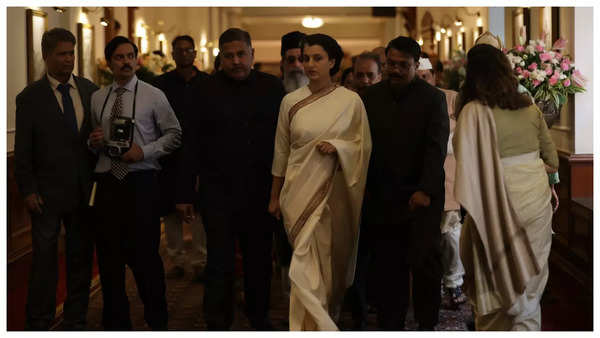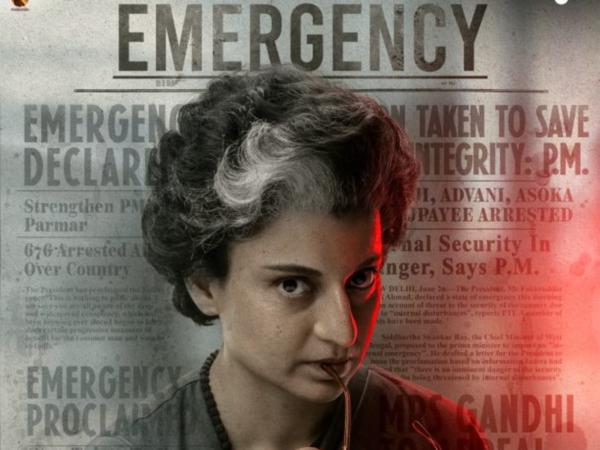[ad_1]
Censorship in Bollywood has long been a contentious issue, with filmmakers frequently grappling with regulatory bodies to preserve their creative visions. The release of Kangana Ranaut’s latest film, Emergency, offers a fresh lens to examine the intersection of cinema, politics, and censorship in India. This film, which delves into the controversial period of the Emergency in India (1975-1977) under Prime Minister Indira Gandhi, has found itself mired in controversy and bureaucratic hurdles, with the Central Board of Film Certification (CBFC), sparking a renewed debate on freedom of expression in the world’s largest democracy.
Kangana Ranaut’s ‘Emergency’ In Jeopardy; Censor Board Refuses Certification
Emergency is a historical drama that centers around one of the most tumultuous periods in Indian history. In June 1975, the then-Prime Minister Indira Gandhi declared a state of Emergency across the country, citing internal disturbances. This period, which lasted until March 1977, was marked by widespread censorship of the press, suspension of civil liberties, mass arrests of political opponents, and forced sterilizations. The film, directed and produced by Kangana Ranaut, who also plays the role of Indira Gandhi, aims to provide a dramatic recounting of these events, exploring both the political landscape and the personal life of the Prime Minister during that era.
Given the subject matter, Emergency was always poised to face scrutiny. India’s political past, especially events involving high-profile leaders, remains a sensitive topic, often seen through partisan lenses. As a result, the film’s narrative choices, portrayal of key figures, and interpretation of historical events were likely to attract attention not just from audiences, but also from the authorities.
Talking about censorship, Anubhav Sinha, who has been in the eye of the storm because of his show IC 814: The Kandahar Hijack, in an interview with Indian Express said, “If it is a Utopian question, then everything should be made and released, but there is a law of the land, and if that tells me if you don’t do this, you can’t release your film, I will have to follow suit. Now, I can’t have a cerebral utopian conversation about it. CBFC is the law of the land. It tells me, ‘Anubhav, if you want to release your film, you have to delete this,’ I have to delete this. As simple as that.”
Censorship in Bollywood – A Historical overview
Censorship in Bollywood is not a new phenomenon. The CBFC, colloquially known as the Censor Board, has the authority to approve, demand cuts, or ban films under the Cinematograph Act of 1952. The board’s stated mission is to ensure that the content of films is suitable for public viewing and adheres to the moral standards of society. Over the decades, the CBFC’s decisions have often reflected the prevailing socio-political climate of the times. Several films over the years have faced the wrath of the censor board for tackling sensitive issues. Anurag Kashyap’s 2001 film Paanch was banned by the board despite cuts.
Just last month, Nikkhil Advani’s Vedaa had to face the censor’s axe. The filmmaker had revealed that despite submitting the film in advance, it had not received the censor certificate. The situation finally came to a resolution with over 9 minutes of Vedaa being chopped, and the film being awarded UA certification. Talking about his experience Nikkhil said, “I am so so thrilled with the way the Revising Committee appreciated the film and have chosen to certify it with a UA, allowing the film to be viewed by the larger audience. I was very happy when they emphasized that they “had not touched this very important story” and had only recommended a revision of some language in order for it to be certified as U/A.”
Movies like Udta Punjab, which dealt with drug abuse in Punjab, and Lipstick Under My Burkha, a film about the secret lives of four women, faced significant censorship before their release. These examples underscore the recurring tension between artistic expression and regulatory oversight in Bollywood. Sharing his opinion on the impact on movie business because of delays in releases caused because of censorship, trade expert Taran Adarsh says , “When a film gets delayed, everything goes for a toss, even the promotions. So the team has to restart the promotions whenever you get the new release date, and that is an additional expenditure. Next is the interest factor, which is the most killing part. Producer has borrowed money from the financier and he/she has to pay an interest now depending on the delay, which could take months, but the interest keeps on adding, and by the time one releases the film, your planned budget and the actual budget sounds very different.”
Adding more, trade expert Girish Wankhede says, “When a film gets postponed, the excitement for the film amongst the audience starts to dissipate, and exhibitors also start to lose interest in the showcasing of the film as they give priority to other releases.”
Emergency Release Confirmed: Kangana Ranaut Responds To Death Threats | WATCH
Emergency and the Censor Board: A New Battleground
The case of Emergency represents the latest flashpoint in this ongoing battle leading to the film being pushed ahead from its 6th September release.The actress turned MP Kangana Ranaut claimed that film’s clearance from CBFC was halted because the members of the board began to get threats.
The issue began with the trailer showing Jarnail Singh Bhindranwale, leader of the separatist Khalistan movement, being depicted as a conniving person who promised to bring voters to Congress in exchange for a separate Sikh state. It led to the Delhi Sikh Gurdwara Management Committee (DSGMC) sending letters to the Central Board of Film Certification (CBFC) and the Ministry of Information and Broadcasting, urging a ban on the film. They alleged that the trailer misrepresents the Sikh community and it could incite hatred. In its report, India Today stated the reason for the delay, quoting a source said religious sentiments cannot be hurt.
This has not gone down well with Kangana Ranaut, who has publicly criticized the board’s decision, arguing that the film is a truthful representation of history and that artistic freedom should not be curtailed by political considerations. She has pointed out that her film is based on documented events, and insists that it should be viewed as a work of art rather than a political commentary.
Kangana Ranaut UNCENSORED Interview I Real Reason Why She Wore PRODUCER Hat | EMERGENCY
The Debate on Artistic Freedom and Historical Accuracy
The controversy surrounding Emergency brings to the fore a critical debate about the balance between artistic freedom, and the need to maintain public order and respect for historical figures. Proponents of censorship argue that films have a far-reaching impact on society and can influence public perception, especially in a country as diverse and politically sensitive as India. They maintain that the CBFC’s role is to ensure that films do not incite violence, offend religious or cultural sentiments, or disrupt public order. On the other hand, critics of censorship, including many in the film industry, argue that such controls are often arbitrary and politically motivated. They contend that films are a form of artistic expression, and that filmmakers should have the liberty to present their interpretations of historical events. Furthermore, they argue that censorship stifles creativity and inhibits filmmakers from tackling important social and political issues.
Political Sensitivities and Their Impact on Cinema
The case of Emergency also highlights how political sensitivities influence cinema in India. Films that depict political events or figures often find themselves in the crosshairs of not just the censor board, but also political parties and interest groups. In recent years, movies like Padmaavat, and Article 15 have faced violent protests and legal battles due to their portrayal of historical events and social issues.

The Role of the Judiciary
The judiciary in India has often been the arbiter in cases involving censorship. In the past, courts have overturned CBFC decisions, stating that films should not be censored for the sake of protecting political interests or public figures. For instance, in the case of Udta Punjab, the Bombay High Court ruled in favor of the filmmakers, stating that the audience is mature enough to make its own decisions about what to watch. Kangana Ranaut and her producers have also approached the Bombay High Court with regards to withholding its censor certificate.

Kangana Ranaut starrer ‘Emergency’ poster
The Future of Censorship in Bollywood
The ongoing controversy over Emergency suggests that censorship will continue to be a major issue in Bollywood, especially as filmmakers become bolder in tackling politically sensitive subjects. While the CBFC’s role as a regulatory body is necessary to some extent, there is a growing demand for a more transparent and consistent approach to film certification. Many in the industry are calling for a complete overhaul of the CBFC and its guidelines, advocating for a system that respects artistic freedom while ensuring that content is appropriate for all audiences. The creation of a rating system, similar to those used in the West, has been suggested as one potential solution.
The censorship issues surrounding Kangana Ranaut’s Emergency serve as a microcosm of the larger battle for creative freedom in Bollywood. As filmmakers continue to push the boundaries of storytelling, the clash between artistic expression and regulatory oversight is likely to intensify. In a vibrant democracy like India, it is crucial to find a balance that respects both the creative autonomy of filmmakers, and the diverse sentiments of its audience. How this balance is struck will determine the future of Indian cinema and its role in society.
[ad_2]
Source link